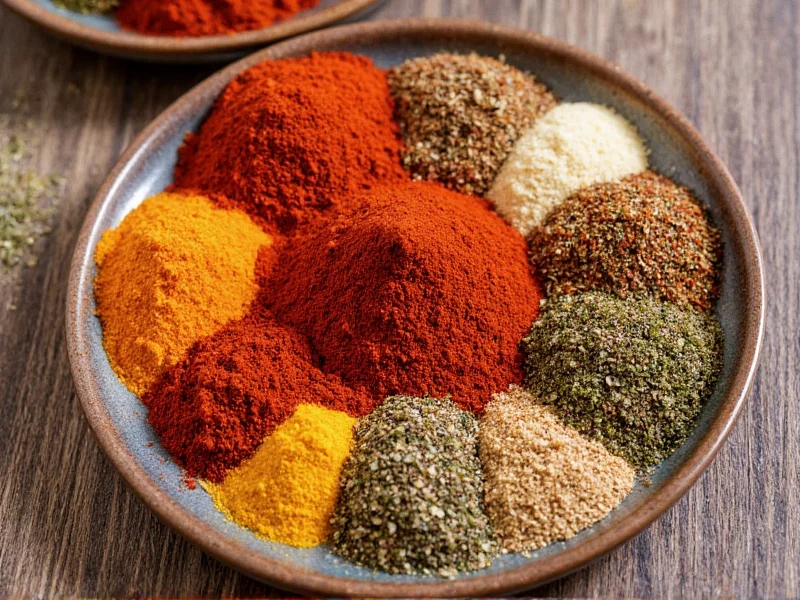Understanding exactly what's in Italian seasoning helps home cooks make informed choices in the kitchen. While the blend seems simple, the specific herbs and their ratios significantly impact flavor profiles. Let's explore the components, variations, and culinary applications of this essential pantry staple.
Core Herbs in Traditional Italian Seasoning
Authentic Italian seasoning contains five primary dried herbs, each contributing unique flavor notes that combine to create that distinctive Mediterranean taste:
| Herb | Flavor Profile | Typical Proportion |
|---|---|---|
| Oregano | Earthy, slightly bitter, robust | 25-30% |
| Basil | Sweet, slightly peppery, aromatic | 20-25% |
| Thyme | Subtle lemon notes, earthy | 15-20% |
| Rosemary | Pine-like, strong, woody | 10-15% |
| Marjoram | Milder than oregano, sweet floral notes | 10-15% |
These proportions represent common commercial blends, though artisanal and homemade versions often adjust ratios based on regional preferences or intended use. The balance between oregano's boldness and marjoram's sweetness creates the characteristic flavor profile that defines quality Italian seasoning.
Regional and Brand Variations
What's in Italian seasoning can differ significantly depending on where it's produced. American commercial blends often contain additional ingredients not traditionally used in Italy:
- North American versions frequently include garlic powder, onion powder, or red pepper flakes
- European imports typically stick to the five-herb foundation without additives
- Regional Italian blends might emphasize certain herbs based on local cuisine (e.g., more rosemary in Tuscany-inspired blends)
When examining an Italian seasoning ingredients list, check for fillers like maltodextrin or anti-caking agents. Premium blends contain only herbs and occasionally salt. Understanding these differences helps you select the right product for authentic Italian cooking versus American-Italian dishes.
History of Italian Seasoning as a Commercial Blend
Interestingly, the pre-mixed Italian seasoning blend we know today isn't traditionally Italian. Italians typically combine fresh herbs individually rather than using pre-mixed dried blends. The concept emerged in mid-20th century America as Italian-American cuisine gained popularity.
Food manufacturers created this convenient blend to simplify cooking for American home chefs unfamiliar with Mediterranean herbs. The standardized mixture made it easier to replicate Italian flavors without sourcing multiple individual dried herbs. Despite its American origins, the blend has become so ubiquitous that many now consider it an authentic Italian pantry staple.
Practical Culinary Applications
Knowing what's in Italian seasoning helps you use it effectively. This versatile blend works best in dishes where the herbs can infuse flavors throughout cooking:
- Pasta sauces - Add during simmering to allow flavors to meld
- Marinades for meats - Combine with olive oil for chicken, pork, or beef
- Roasted vegetables - Toss with olive oil and seasoning before roasting
- Bread dipping oils - Mix with extra virgin olive oil for authentic Italian presentation
- Pizza - Sprinkle on before baking for enhanced flavor
For best results, add Italian seasoning early in the cooking process to allow the dried herbs to rehydrate and release their oils. Unlike fresh herbs added at the end, dried blends need time to infuse dishes with flavor.
Creating Your Own Italian Seasoning Blend
When you make homemade Italian seasoning, you control quality and proportions. This simple recipe yields a superior blend to most commercial options:
- Combine 2 tablespoons dried oregano
- Add 1½ tablespoons dried basil
- Mix in 1 tablespoon dried thyme
- Incorporate 2 teaspoons dried rosemary (crushed)
- Add 2 teaspoons dried marjoram
- Optional: 1 teaspoon garlic powder for American-style blend
Store your homemade Italian seasoning in an airtight container away from light and heat. Properly stored, it maintains peak flavor for 6-12 months. Freshly blended seasoning always outperforms store-bought versions that may have been sitting on shelves for extended periods.
Substitutions and Alternatives
If you're wondering what to use instead of Italian seasoning, several options exist depending on your needs:
- Herbes de Provence - Similar but contains lavender (not traditional in Italian cooking)
- Individual herbs - Use 1 teaspoon oregano plus ½ teaspoon each basil and thyme
- Pizza seasoning - Often includes additional garlic and red pepper
- Homemade blend - As shown above for superior freshness
When substituting, consider the dish you're preparing. For authentic Italian recipes, stick to the core herb combination without garlic or red pepper unless specified. American-Italian dishes often welcome those additional elements.
Quality Considerations When Purchasing
Not all Italian seasoning blends deliver equal quality. When selecting a product, check for these markers of quality:
- Color consistency - should be vibrant green, not brown or faded
- Strong aroma when opened - weak smell indicates old herbs
- Simple ingredients list - ideally just herbs, no fillers
- Origin information - Mediterranean-grown herbs often have superior flavor
Higher quality Italian seasoning contains whole or coarsely ground herbs rather than fine powder, preserving essential oils and flavor compounds. While more expensive, premium blends deliver noticeably better results in your cooking.











 浙公网安备
33010002000092号
浙公网安备
33010002000092号 浙B2-20120091-4
浙B2-20120091-4